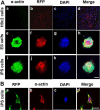Induced pluripotent stem (iPS) cells repair and regenerate infarcted myocardium
- PMID: 21542647
- PMCID: PMC6309322
- DOI: 10.1021/mp2001704
Induced pluripotent stem (iPS) cells repair and regenerate infarcted myocardium
Abstract
Cardiac myocyte differentiation reported thus far is from iPS cells generated from mouse and human fibroblasts. However, there is no article on the generation of iPS cells from cardiac ventricular specific cell types such as H9c2 cells. Therefore, whether transduced H9c2 cells, originally isolated from embryonic cardiac ventricular tissue, will be able to generate iPS cells and have the potential to repair and regenerate infarcted myocardium remains completely elusive. We transduced H9c2 cells with four stemness factors, Oct3/4, Sox2, Klf4, and c-Myc, and successfully reprogrammed them into iPS cells. These iPS cells were able to differentiate into beating cardiac myocytes and positively stained for cardiac specific sarcomeric α-actin and myosin heavy chain proteins. Following transplantation in the infarcted myocardium, there were newly differentiated cardiac myocytes and formation of gap junction proteins at 2 weeks post-myocardial infarction (MI), suggesting newly formed cardiac myocytes were integrated into the native myocardium. Furthermore, transplanted iPS cells significantly (p < 0.05) inhibited apoptosis and fibrosis and improved cardiac function compared with MI and MI+H9c2 cell groups. Moreover, our iPS cell derived cardiac myocyte differentiation in vitro and in vivo was comparable to embryonic stem cells in the present study. In conclusion we report for the first time that we have H9c2 cell-derived iPS cells which contain the potential to differentiate into cardiac myocytes in the cell culture system and repair and regenerate infarcted myocardium with improved cardiac function in vivo.
Figures






Similar articles
-
Transplanted induced pluripotent stem cells improve cardiac function and induce neovascularization in the infarcted hearts of db/db mice.Mol Pharm. 2011 Oct 3;8(5):1602-10. doi: 10.1021/mp2003576. Epub 2011 Sep 8. Mol Pharm. 2011. PMID: 21851072
-
MicroRNA-1 transfected embryonic stem cells enhance cardiac myocyte differentiation and inhibit apoptosis by modulating the PTEN/Akt pathway in the infarcted heart.Am J Physiol Heart Circ Physiol. 2011 Nov;301(5):H2038-49. doi: 10.1152/ajpheart.00271.2011. Epub 2011 Aug 19. Am J Physiol Heart Circ Physiol. 2011. PMID: 21856911 Free PMC article.
-
Repair of acute myocardial infarction by human stemness factors induced pluripotent stem cells.Circulation. 2009 Aug 4;120(5):408-16. doi: 10.1161/CIRCULATIONAHA.109.865154. Epub 2009 Jul 20. Circulation. 2009. PMID: 19620500 Free PMC article.
-
iPS cells: a source of cardiac regeneration.J Mol Cell Cardiol. 2011 Feb;50(2):327-32. doi: 10.1016/j.yjmcc.2010.10.026. Epub 2010 Oct 30. J Mol Cell Cardiol. 2011. PMID: 21040726 Review.
-
Embryonic template-based generation and purification of pluripotent stem cell-derived cardiomyocytes for heart repair.J Cardiovasc Transl Res. 2012 Oct;5(5):566-80. doi: 10.1007/s12265-012-9391-6. Epub 2012 Jul 18. J Cardiovasc Transl Res. 2012. PMID: 22806916 Review.
Cited by
-
Electrical effects of stem cell transplantation for ischaemic cardiomyopathy: friend or foe?J Physiol. 2016 May 1;594(9):2511-24. doi: 10.1113/JP270540. Epub 2016 Jan 19. J Physiol. 2016. PMID: 26584682 Free PMC article. Review.
-
Persistence of intramyocardially transplanted murine induced pluripotent stem cell-derived cardiomyocytes from different developmental stages.Stem Cell Res Ther. 2021 Jan 8;12(1):46. doi: 10.1186/s13287-020-02089-5. Stem Cell Res Ther. 2021. PMID: 33419458 Free PMC article.
-
Two promising approaches in the treatment of myocardial infarction: stem cells and gene therapy.Front Cardiovasc Med. 2025 Feb 19;12:1540066. doi: 10.3389/fcvm.2025.1540066. eCollection 2025. Front Cardiovasc Med. 2025. PMID: 40046966 Free PMC article. Review.
-
Induced pluripotent stem cell intervention rescues ventricular wall motion disparity, achieving biological cardiac resynchronization post-infarction.J Physiol. 2013 Sep 1;591(17):4335-49. doi: 10.1113/jphysiol.2013.252288. Epub 2013 Apr 8. J Physiol. 2013. PMID: 23568891 Free PMC article.
-
Intramyocardial Injection of Pig Pluripotent Stem Cells Improves Left Ventricular Function and Perfusion: A Study in a Porcine Model of Acute Myocardial Infarction.PLoS One. 2013 Jun 21;8(6):e66688. doi: 10.1371/journal.pone.0066688. Print 2013. PLoS One. 2013. PMID: 23805264 Free PMC article.
References
-
- Anversa P, Olivetti G, Leri A, Liu Y, Kajstura J. Myocyte cell death and ventricular remodeling. Curr. Opin. Nephrol. Hypertens. 1997;6:169–176. - PubMed
-
- Haider HK, Ashraf M. Bone marrow cell transplantation in clinical perspective. J. Mol. Cell Cardiol. 2005;38:225–235. - PubMed
-
- Kajstura J, Rota M, Whang B, Cascapera S, Hosoda T, Bearzi C, Nurzynska D, Kasahara H, Zias E, Bonafe M, Nadal-Ginard B, Torella D, Nascimbene A, Quaini F, Urbanek K, Leri A, Anversa P. Bone marrow cells differentiate in cardiac cell lineages after infarction independently of cell fusion. Circ. Res. 2005;96:127–137. - PubMed
-
- Orlic D, Kajstura J, Chimenti S, Jakoniuk I, Anderson SM, Li B, Pickel J, McKay R, Nadal-Ginard B, Bodine DM, Leri A, Anversa P. Bone marrow cells regenerate infarcted myocardium. Nature. 2001;410:701–705. - PubMed
Publication types
MeSH terms
Substances
Grants and funding
LinkOut - more resources
Full Text Sources
Other Literature Sources
Medical
Miscellaneous

